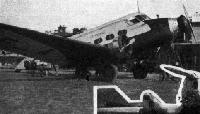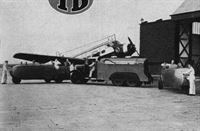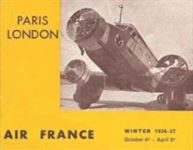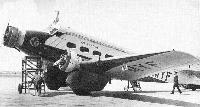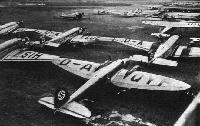
Варианты
- Wibault - Wibault 280 - 1930 - Франция
- Breguet-Wibault - 670 - 1935 - Франция
Flight, December 1930
The PARIS AERO SHOW
WIBAULT
The machine shown by Michel Wibault is a large all-metal three-engined low-wing monoplane, not unlike a Junkers in general lay-out, but with flat metal plating instead of the corrugated covering which Junkers favours. In spite of its size, and the fact that it is fitted with three Gnome-Rhone "Titans" of 300-h.p. each, the Wibault carries but 10 passengers.
It will be recollected that hitherto Michel Wibault has used in most of his machines a form of wing construction in which the ribs projected through the metal wing covering, the latter being in panels with turned-up edges. The new machine, type 280 T 10, shows an entirely different form of wing construction. There are two main spars and a number of stringers. The ribs do not project through the covering, and the latter is riveted to the stringers in small flat panels. We had the pleasure of a short chat with M. Wibault himself on the stand and he informed us that quite a considerable increase in speed was obtained by the smooth wing covering, the upstanding edges of the covering in the older Wibault machines presumably disturbing the air flow to some extent. The fuselage, like the wings, is covered with smooth plates without the fore and aft corrugations which one has hitherto associated with Wibault machines.
When fitted with three Gnome-Rhone "Titans," the Wibault 280 T 10 has the following dimensions, weights, etc.: Length, 17 m. (55 ft. 9 in.); wing span, 22 m. 600 (74 ft. 2 in.); wing area, 63-5 m.3 (683 sq. ft.); tare weight, 3,555 kg. (7,820 lb.); gross weight, 5,750 kg. (12,650 lb.). The machine has not yet been flown, and performance figures are not, therefore, available.
Описание:
- Flight, December 1930
The PARIS AERO SHOW - Flight, July 1931
WIBAULT-PENHOET 281 T. 12
Фотографии
-
Aeroplane Monthly 1984-09 / J.Stroud - Wings of Peace
Регистрационный номер: F-AMHK [2] CIDNA s Wibault-Penhoet 282.T12 F-AMHK, the first production aeroplane.
-
Aeroplane Monthly 1984-09 / J.Stroud - Wings of Peace
Регистрационный номер: F-AKEK [2] The original Wibault 280T prototype in Air France livery after being converted to 283.T12.
-
Aeroplane Monthly 1984-09 / J.Stroud - Wings of Peace
Регистрационный номер: F-AMHN Air Union's Wibault-Penhoet 282.T12 F-AMHN, in Golden Clipper gold and red livery, flying near Croydon in 1933.
-
Flight 1931-07 / Flight
Регистрационный номер: F-ADEK [2] -
Flight 1931-06 / Flight
Регистрационный номер: F-ADEK [2] NEW COMMERCIAL MACHINE AT VINCENNES: The Wibault 3-engined (250 h.p. Wright Hispano) all-metal transport
-
Aeroplane Monthly 1984-09 / J.Stroud - Wings of Peace
Регистрационный номер: F-AKEK [2] The first prototype Wibault 280T after delivery to the Government and conversion to 281.T10 with 300 h.p. Titan engines.
-
Aeroplane Monthly 1984-09 / J.Stroud - Wings of Peace
Регистрационный номер: F-AMYD [2] Wibault 283.T12 F-AMYD outside the old Le Bourget terminal.
-
Aeroplane Monthly 1984-09 / J.Stroud - Wings of Peace
Регистрационный номер: F-AKEL [3] Wibault 282.T12 of Air France, Le Rapide, at Croydon in 1937.
-
Aviation Historian 41 / D.Stringer - Around the world in 28 days!
Регистрационный номер: F-AKEL [3] In October 1933 the newly inaugurated Air France introduced the Wibault 282.T12 into service. Capable of carrying ten passengers at 150 m.p.h. (240km/h), the low-wing monoplane trimotor was operated on the airline’s main European services until 1938, when it was relegated to secondary routes. This example, F-AKEL, was originally built as the second 280.T but was upgraded to 282.T12 standard with more powerful engines for Air France.
-
Aeroplane Monthly 1984-09 / J.Stroud - Wings of Peace
Регистрационный номер: F-AMHK [2] Air France’s Wibault 282.T12 F-AMHK at Croydon with extra heightened rudder and small fins.
-
Flight 1933-09 / Flight
The Wibault-Penhoet, another type used by Air-France.
-
Flight 1933-10 / Flight
THE "GOLDEN CLIPPER" AT CROYDON: The Wibault Penhoet of Air-France about to leave for Paris. Owing to a confusion in the rate of exchange in the "Gold Standard" it was stated in our issue of September 21 last that the "Golden Clipper" was a Loire et Olivier - of course, the latter class are "Golden Rays." Just a little Golden Slipper on our part!
-
Flight 1936-01 / Flight
THREE DAYS TO CHILE. Air France inaugurated its South Atlantic mail service last Saturday. On the picture is a scene at Croydon on Saturday, with the mail being loaded into a Wibault-Penhoet for the first stage.
-
Flight 1933-09 / Flight
One of the French commercial aircraft which were flown to Moscow to show the Russians what France can produce in this way. The Wibault-Penhoet 282T.
-
Flight 1930-12 / Flight
The Wibault 3-engined monoplane is characterised by a perfectly straight back. This is probably to avoid panel beating.
-
Aeroplane Monthly 1984-09 / J.Stroud - Wings of Peace
Регистрационный номер: F-AMYD [2] Air France s dark blue and silver Wibault-Penhoet 283.T12 F-AMYD Le Glorieux. The tail is unmodified in spite of the undercarriage pants.
-
Flight 1938-03 / Flight
The 10-passenger 150-m.p.h. Wibault 283 (1934)
-
Aviation Historian 41 / D.Stringer - Around the world in 28 days!
Регистрационный номер: F-AKEL [3] This example, F-AKEL, was originally built as the second 280.T but was upgraded to 282.T12 standard with more powerful engines for Air France, as seen on the Winter 1936–37 timetable.
-
Мировая Авиация 9
Регистрационный номер: F-AMYF 31 октября 1933г. Министр авиации Франции Пьер Кот официально открыл новую национальную авиакомпанию "Air France", которая поглотила несколько небольших авиакомпаний. Основанием для создания крупной авиакомпании стали сугубо экономические причины: государству проще было поддерживать одну крупную авиакомпанию, чем несколько мелких. Мелкие авиакомпании нередко покупали недостаточно надежные самолеты, а при заказе разработки новых самолетов главным критерием являлась низкая стоимость летательных аппаратов. Как результат, парк авиакомпании "Air France" составили 259 самолетов 35 разных типов, в том числе большое количество одномоторных машин.
-
Flight 1936-05 / Flight
BROMMA IN ACTION: Transport machines of three nations at Stockholm's airport. On the ground are a British Continental Airways' D.H. 86 A and a Breguet-Wibault of Air France, while in the air is the Von Hindenburg, one of D.L.H.'s two Junkers G.38s, which have Jumo diesel engines.
Другие самолёты на фотографии: De Havilland Express Air Liner / D.H.86 - Великобритания - 1934Junkers G 38 - Германия - 1929
-
Flight 1936-12 / Flight
CHRISTMAS RUSH: A tarmac impression at Croydon on December 24. Beneath the port wing of the Swissair Douglas can be seen an Air France Wibault, an H.P. 42, Scylla and Syrinx, while behind the Douglas is a Railway Air Services' D.H.86.
Другие самолёты на фотографии: De Havilland Express Air Liner / D.H.86 - Великобритания - 1934Douglas DC-1 / DC-2 / C-32 / C-39 - США - 1933Handley Page H.P.42 / H.P.45 - Великобритания - 1930Short Scylla / L.17 - Великобритания - 1934
-
Aeroplane Monthly 1976-03 / Personal album
Регистрационный номер: F-AMHM [2] This view of Croydon in 1938 shows British Airways' D.H.86A G-ADEC nearest the camera. This aircraft began life in 1935 with Hillmans Airways, and was absorbed into British Airways the following year. Shortly after this photograph was taken 'EC was sold to Uruguay as CX-AAH. The centre aircraft of the group is KLM's DC-2 PH-AKH, Haan, with Air France's three engined Wibault Penhoet F-AMHM in the background.
Другие самолёты на фотографии: De Havilland Express Air Liner / D.H.86 - Великобритания - 1934Douglas DC-1 / DC-2 / C-32 / C-39 - США - 1933
-
Aeroplane Monthly 1977-01 / G.Endres - Czechoslovakian Air Transport since 1920 (1)
Регистрационный номер: F-AMYE The apron at Prague Ruzyne airport in 1938, with three DC-2s, a Fokker FVIIb-3m, an Avia F.39, a Wibault 283.T and a Potez 62 in evidence.
Другие самолёты на фотографии: Douglas DC-1 / DC-2 / C-32 / C-39 - США - 1933Fokker F.IX / F.XII / F.XVIII - Нидерланды - 1929Fokker F.VII / C-2 / F.XIV - Нидерланды - 1924Potez Potez 62 / 65 - Франция - 1935
-
Flight 1937-02 / Flight
International convention at Tempelhof - Heinkel He.111, Junkers Ju.52, Danish Fokker, French Wibault, and others.
Другие самолёты на фотографии: Fokker F.IX / F.XII / F.XVIII - Нидерланды - 1929Heinkel He-111 - Германия - 1935Junkers Ju.52/3m - Германия - 1931
-
Aeroplane Monthly 1987-09 / J.Stroud - Wings of Peace
The D.333 F-ANQA Antares at Le Bourget. In the background is an Air France Wibault 283.
Другие самолёты на фотографии: Dewoitine D.332 / D.333 / D.338 / D.620 - Франция - 1933
-
Aeroplane Monthly 1986-05 / J.Stroud - Wings of Peace
Регистрационный номер: F-AMHM [2] F-ANPI with Gnome-Rhone Mistral Major engines. These engines had opposite rotation, as can be seen from the propellers. In the background is the Wibault 282.T12 F-AMHM.
Другие самолёты на фотографии: Potez Potez 62 / 65 - Франция - 1935
-
Aeroplane Monthly 1984-09 / J.Stroud - Wings of Peace
The austere flight deck of the Wibault 281.T10 prototype may not have been representative of production aircraft.
-
Aeroplane Monthly 1984-09 / J.Stroud - Wings of Peace
Interior of an Air France Wibault-Penhoet 282.T12.
-
Aeroplane Monthly 1984-09 / J.Stroud - Wings of Peace
Регистрационный номер: F-AMHO KEITH WOODCOCK'S painting illustrates F-AMHO, one of Air Union's Wibault-Penhoet 282.T12s
- Фотографии













